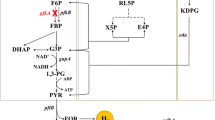Abstract
Improvements in pyruvate production process were examined using Escherichia coli BW25113∆pta/pHfdh strain carrying the formate dehydrogenase gene of Mycobacterium vaccae to change the redox status of the cells. Glucose and formate concentrations, and oxygenation levels determined previously in a shake-flask culture were applied for pyruvate production in a 1 l fermenter. However, pyruvate was not produced under the examined conditions. Detailed pH measurements during the fermenter culture using CaCO3 revealed that maintaining the pH value around 6.0 plays an important role in stabilizing the pyruvate accumulation. In the pH-adjusting culture around 6.0 with NaOH solution, the concentration and yield of pyruvate were 8.96 g l−1 and 0.48 g pyruvate g glucose−1, respectively, which were significantly higher than the values reported in the shake-flask culture (6.79 g l−1 and 0.32 g pyruvate g glucose−1).



Similar content being viewed by others
References
Causey TB, Shanmugam KT, Yomano LP, Ingram LO (2004) Engineering Escherichia coli for efficient conversion of glucose to pyruvate. Proc Natl Acad Sci USA 101:2235–2240
Tomar A, Eiteman MA, Altman E (2003) The effect of acetate pathway mutations on the production of pyruvate in Escherichia coli. Appl Microbiol Biotechnol 62:76–82
Yokota A, Shimizu H, Terasawa Y, Takaoka N, Tomita F (1994) Pyruvic acid prediction by a lipoic acid auxotroph of Escherichia coli W1485. Appl Microbiol Biotechnol 41:638–643
Yokota A, Henmi M, Takaoka N, Hayashi C, Terasawa Y, Fukumori Y, Tomita F (1997) Enhancement of glucose metabolism in a pyruvic acid-hyper producing Escherichia coli mutant defective in F1-ATPase activity. J Ferment Bioeng 83:132–138
Noda S, Takezawa Y, Mizutani T, Asakura T, Nishiumi E, Onoe K, Wada M, Tomita F, Matsushita K, Yokota A (2006) Alterations of cellular physiology in Escherichia coli in response to oxidative phosphorylation impaired by defective F1-ATPase. J Bacteriol 188:6869–6876
Ojima Y, Suryadarma P, Tsuchida K, Taya M (2012) Accumulation of pyruvate by changing the redox status in Escherichia coli. Biotechnol Lett 34:889–893
Cooper CM, Fernstrom GA, Miller SA (1944) Performance of agitated gas–liquid contactors. Ind Eng Chem 36:504–509
Cassey B, Guest JR, Attwood MM (1998) Environmental control of pyruvate dehydrogenase complex expression in Escherichia coli. FEMS Microbiol Lett 159:325–329
Dittrich CR, Bennett GN, San KY (2005) Characterization of the acetate-producing pathways in Escherichia coli. Biotechnol Prog 21:1062–1067
Acknowledgments
This study was supported in part by the Sapporo Bioscience Foundation. We thank Dr. Kurihara of Kyoto University for kindly providing the pFDHADH plasmid.
Author information
Authors and Affiliations
Corresponding author
Rights and permissions
About this article
Cite this article
Ojima, Y., Matsuo, N., Suparman, A. et al. Altered redox status in Escherichia coli cells enhances pyruvate production in pH-adjusting culture with a fermenter. Bioprocess Biosyst Eng 37, 377–381 (2014). https://doi.org/10.1007/s00449-013-1002-7
Received:
Accepted:
Published:
Issue Date:
DOI: https://doi.org/10.1007/s00449-013-1002-7




